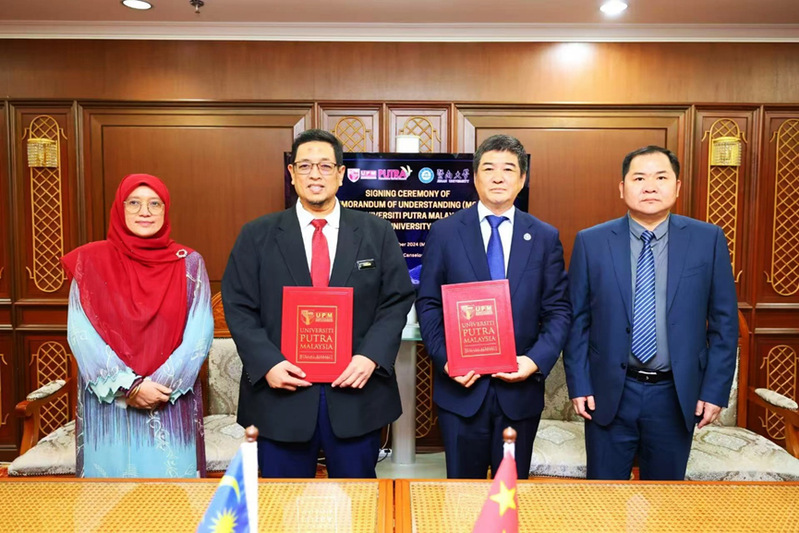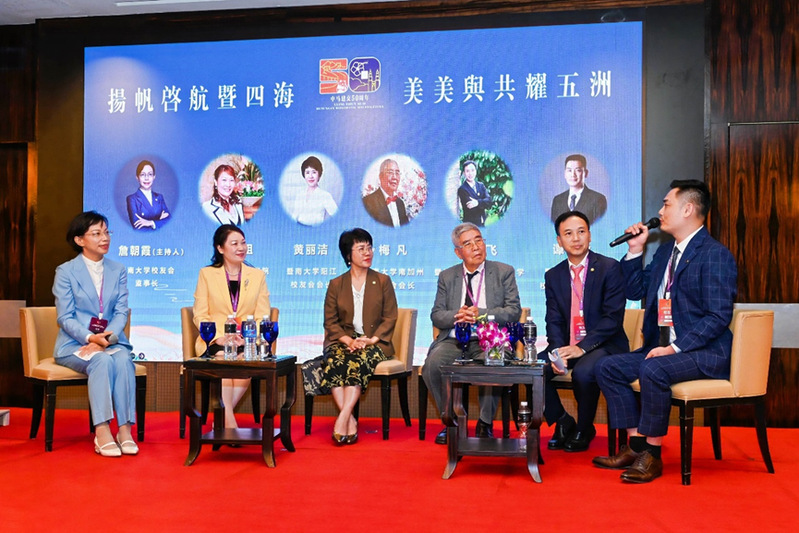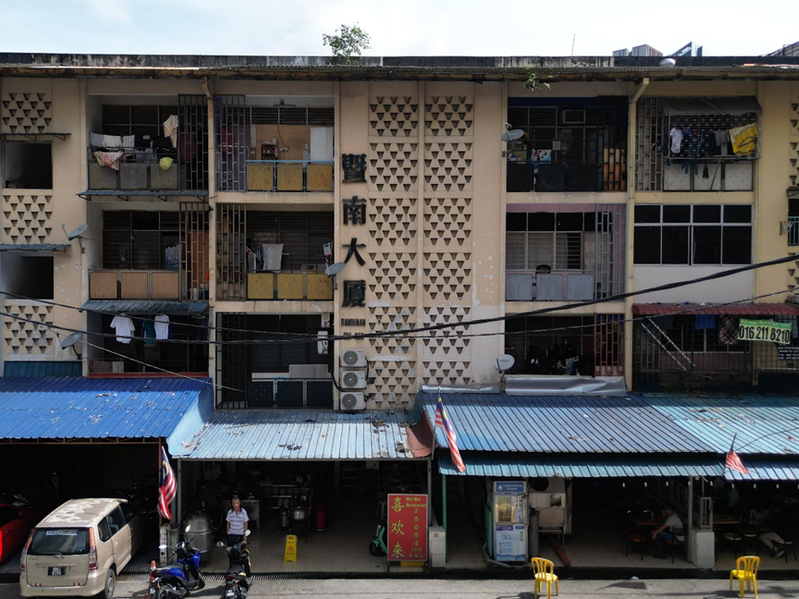- ABOUT JNU
- ADMISSION
-
ACADEMICS
- Schools and Colleges
-
Departments and Programs
- Arts College of
- Chinese Language and Culture College of
- Economics College of
- Electrical and Information Engineering College of
- Foreign Studies College of
- Information Science and Technology College of
- Environment School of
- Humanities School of
- International Business School
- International Studies School of
- Journalism and Communication College of
- Law School
- Liberal Arts College of
- Life Science and Technology College of
- Management School of
- Marxism School of
- Medicine School of
- Pharmacy College of
- Physical Education School of
- Science and Engineering College of
- Shenzhen Tourism College
- Research Institute
- Research Center
- Programs in English
- Majors
- Study Abroad
- Online Learning
- RESEARCH
- CAMPUS LIFE
- JOIN US
Jinan University and Malaysia: A Century of Love Weaving the Cultural Silk Road
Author: Su Yunsheng
Publisher: JNU News Center
Date: March 28, 2025
As Jinan University prepares to celebrate its 120th anniversary in 2026, it embarks on a mission to share its rich cultural heritage globally, inspired by the important speech delivered by General Secretary Xi Jinping during his inspection of the university. To highlight the contributions of Jinan people in promoting traditional Chinese culture worldwide, the university has launched an extensive media interview program titled “Jinan University Inherits and Disseminates Excellent Traditional Chinese Culture to Overseas, Hong Kong, Macao, and Taiwan.” This initiative focuses on engaging school directors and alumni from around the globe, sharing stories about Jinan's education initiatives and cultural outreach, and reflecting the patriotism and mission of its community.
Celebrating Collaboration and Achievements
On November 17, 2024, the China-Malaysia Joint Laboratory for Oil Processing and Safety was inaugurated in Kuala Lumpur. This landmark facility represents the first joint laboratory established under the “Belt and Road” initiative, exemplifying high-level cooperation between Jinan University and Universiti Putra Malaysia. Focusing on the green processing of palm oil, this joint laboratory aims to transform scientific innovations into practical industrial applications. Xing Feng, an academician and president of Jinan University, remarked, “In the laboratory, palm oil can also smell like a scroll of books. We need to move more scientific and technological achievements from papers to production lines.” This collaborative effort is set to pave new avenues for technological transformation in Southeast Asia, supporting sustainable development aligned with the goals of the “Belt and Road” initiative.

(At the unveiling ceremony)
At the unveiling ceremony, Jinan University and Universiti Putra Malaysia also signed a memorandum of understanding to formalize their partnership.
A Gathering of Alumni
The same day, Kuala Lumpur hosted the 6th Alumni Association President and Secretary General Exchange Conference of Jinan University. Over 300 alumni representatives from more than 70 organizations gathered, celebrating their shared commitment to their alma mater. The event featured a review and thanksgiving ceremony for the Gu Runjin Silk Road Fund, which has received over 50 million yuan in donations from Malaysian alumni, reinforcing the enduring friendship between China and Malaysia.

(Roundtable Forum: 6th Alumni Association President and Secretary General Exchange Conference at Jinan University)
Generational Impact
Since its inception, Jinan University has significantly contributed to talent development in Malaysia. Alumni have excelled in various fields, including education, commerce, media, and healthcare. From teachers in Chinese independent high schools to experts in multinational laboratories, and from media pioneers preserving cultural roots to logistics leaders establishing trade avenues, these generations of Jinan alumni have created a rich cultural Silk Road, connecting Chinese civilization and Nanyang culture through their professional endeavors.
A Testament to Heritage
Amidst the bustling streets of Kuala Lumpur, the Jinan Building stands as a historical beacon for the local community. With its four striking black characters resilient against the test of time, this four-story clubhouse serves as the headquarters of the Jinan University Malaysia Alumni Association. Since its completion in 1970, the building has become a cherished symbol of alumni devotion, fostering the transmission of Chinese culture in the region. “It is not just a building; it embodies a spirit,” remarked Lin Guoyuan, former president of the alumni association.

(Jinan Building)
Jinan Building: A Symbol of Connection in Malaysia
Nestled in Kuala Lumpur, the Jinan Building stands as a testament to the enduring connection between Jinan University and its Malaysian alumni. Within its walls, elderly alumni share nostalgic tales while young professionals strategize their futures. Late-night meetings and festive gatherings foster a sense of community, forging an invisible bond that links the red walls of Guangzhou's Shipai Campus with the breezes of Nanyang. This iconic building has become a pivotal venue for alumni association activities, nurturing a legacy that transcends generations.
The origins of the alumni association itself are steeped in passionate history. In 1966, Xie You proposed establishing the association, but his untimely passing cast a shadow over the idea. It wasn't until 1969 that Zhou Yancan reignited the initiative during an alumni gathering in Ipoh. Ten dedicated members traversed the Malay Peninsula, going from Penang to Johor, and engaged in tireless fundraising efforts to secure a home for their community. Finally, in 1970, they succeeded in purchasing the four-story building that stands today, and alumni rejoiced, playfully declaring, “We even have the word 'Jinan' engraved in the cracks of the floor!”
However, challenges loomed large. In 1997, Liu Maruguan’s initial visit to the Jinan Building revealed a stark issue: the presence of only a few elderly members. “Why are there just these few left in such a large alumni association?” she wondered. The historical context revealed that in the 1970s and 1990s, restrictions on Malaysian students studying in China had led to a dwindling membership and a nearly defunct association.
Yet, crises often birth opportunity. Determined to rejuvenate the organization, longtime presidents advocated for amending their articles of association to welcome alumni children. A pivotal moment arrived in 1996 when President Liang Zhanquan enthusiastically declared during a school anniversary, “Let the younger generation take over the torch!” The following year, alumni Qiu Guangyao organized a visit for 20 Malaysian students to the Jinan Building, marking the revival of interest among the youth. Among the visitors was Lin Guoyuan, who later assumed the presidency of the alumni association. His leadership initiated educational exhibitions in high schools, ultimately leading to an increase in Jinan University students from Malaysia, surpassing 100 enrollments.
Today, the first-floor shops within the Jinan Building continue to support the alumni association’s operations as new generations of Jinan alumni look to the future. In 2024, President Wu Yisheng spearheaded the global alumni association's inaugural overseas exchange meeting, bringing together 300 representatives from 70 alumni organizations in Kuala Lumpur. During the event, he invited government officials, entrepreneurs, and members of the Chinese Malaysian community to share their experiences, showcasing Malaysia's rich diversity. “The Jinan spirit knows no geographic boundaries,” he affirmed. This celebration coincided with the 50th anniversary of diplomatic relations between China and Malaysia, promising to further ignite cultural exchange in the years ahead.
The Cultural Contributions of Alumni
The legacy of Jinan University's alumni is further reflected in the work of Gurun Jin, the school director who has devoted three decades to nurturing cultural connections. As a prominent figure in Malaysia, serving as the chairman of both the “Belt and Road” Commission and the Malaysian Chinese Culture and Arts Association, he plays a critical role in fostering economic, cultural, and charitable cooperation between China and Malaysia. In 2019, he established the Gurun Golden Silk Road Fund at Jinan University, aimed at providing enrollment awards for Malaysian students, thereby facilitating access to higher education in their ancestral homeland. By 2024, this fund had invested 6.2 million yuan to support over 150 Malaysian students pursuing studies at Jinan University.
From the early days of Liang Zhanquan’s determination to hang banners, to Lin Guoyuan’s commitment to community engagement, to Wu Yisheng’s vision for global connectivity, the Jinan Building has witnessed the evolution of a vibrant community. It serves as a forum where the founding elders, now over 90 years old, stand shoulder to shoulder with the new generation, forging new chapters in this ongoing story of cultural exchange.
Using Language as a Boat, Crossing the Sea of Culture
In the vibrant classroom of Kuala Lumpur International High School, Yu Weijun wields chalk to transform the contemplative lines of Quiet Night Thoughts into a melody of musical notes. A proud alumnus of Jinan University, Yu has dedicated 19 years to elevating Chinese language education. Through innovative methods, including Paper Cuttings that illustrate solar terms and DIY crafts that celebrate the Year of the Dragon, she shares cultural myths with her students. In a memorable highlight, her class joins in singing True Heroes, where the lyrics “seize every minute of life” resonate deeply with the resilient spirit of the Chinese people.

(Together in Song: Yu Weijun and Students Sing the Chinese Classic Sincere Hero.)
Yu's lessons extend far beyond traditional textbooks; students don costumes to perform Chinese songs, creating “time capsules” of their learning, and during spring, they wave Paper Cuttings to explore the agricultural wisdom behind these customs. This dynamic approach nurtures an emotional bond that connects Chinese and Malaysian cultures, transforming her IGCSE Chinese classroom from a mere requirement into a veritable cultural feast. Thanks to her engaging methods, students consistently achieve A grades, prompting Principal Chen Shuncheng to laud her contributions: She has supported half of the school's Chinese education.
Bridging Cultures Through Literature
Yu Weijun's classroom represents only a glimpse into the broader landscape of Chinese language education in Malaysia. Chinese is the key to opening the door to a new world, she states, highlighting the growing recognition among students’ parents—many of whom are business professionals—of the language's importance on the global stage. Yu's innovative approaches not only enhance language skills but also cultivate a strong sense of identity and pride in Chinese culture.
Complementing this effort is Zeng Weilong, an alumnus and now assistant professor at the Chinese Research Institute as well as head of the Chinese Department at Raman University. Drawing from his undergraduate studies at Jinan University, Zeng analyzes the thoughts and contributions of past scholars, tracing the evolution of Chinese literature. He expresses the sentiment that there will always be those passionate about unearthing untold stories. The academic foundation he received has empowered him to cultivate a unique cross-cultural understanding within the field of literature. Late-night discussions in Jinan's old bookstores have transitioned into confident presentations at academic seminars, placing Malaysian Chinese literature in the limelight of international Sinology research.
Upholding Cultural Heritage
The fight for cultural preservation persists in the backdrop of Malaysia's complex history. In response to assimilation policies from the 1980s that threatened Chinese independent education, alumni like Chen Changxian have actively rallied support across various high schools, organizing education exhibitions and enrollment briefings. The alumni association now sends over a hundred Malaysian freshmen to Jinan University annually, successfully evolving from a friendship organization into a vital cultural force. “What we guard is not only diplomas but also the dignity of our culture,” Chen asserts.
The influence of Jinan alumni also extends into the realm of media. Chen Yunchuan, another graduate, has transitioned from a news anchor to a self-media entrepreneur. She founded the website The Interview, spotlighting Malaysian content creators who share intricate stories in Chinese. Everything about the Internet begins with access, she notes, emphasizing the importance of adapting to the online landscape amid the decline of traditional media. Forming a photography team, she aims to elevate the presence of Chinese culture in Malaysia, stating, “We are not merely cultural porters but decoders and reconstructors of civilization.” This “cross-border explorer,” shaped by her Jinan University roots, bridges traditional and modern media, utilizing critical thinking skills honed in the classroom to break cultural barriers. In her studio, she deftly analyzes the cultural implications of events like the century showdown between Lin Dan and Li Zongwei, embedding contemporary relevance into the narrative of Chinese culture.
Culinary Arts as Cultural Ambassadors
The essence of cultural dissemination also finds expression in the culinary arts, as showcased by Liu Peiwen. Her restaurant, Under the Hibiscus Tree, emanates the bold flavors of Sichuan through dishes like Maocai, transforming food into a medium for cultural dialogue. “True cultural dissemination does not reside in museum specimens, but in the lively aromas and interactions on the streets,” Liu explains. Her meticulously crafted soup base combines the rich heritage of Chengdu food with the vibrant spices of Southeast Asia, mirroring the identity of Malaysian Chinese—finding a delicate balance between tradition and innovation.
In this culinary hub, Chinese food transcends mere sustenance, becoming a taste community that unites diverse ethnicities. The vitality of Chinese culture is thus invigorated through this process of crossing boundaries and taking root in new soil.
Cultural Ambassadors of Jinan University in Malaysia
At the Sabah Health Bureau, Dr. Liao Youjun plays a critical role in the prevention and treatment of tuberculosis and leprosy. This dedicated messenger in white from Jinan University’s Medical College carries the ethos of his alma mater—the motto of loyalty, trustworthiness, and respect engraved on his stethoscope. When the COVID-19 pandemic struck, Dr. Liao and his colleagues bravely ventured into the frontline, meticulously collating vast amounts of data that informed vital prevention and control decisions. In his view, while medicine serves as a universal language that transcends racial lines, a nuanced understanding of cultural contexts enriches compassionate care.
In another corner of Kuala Lumpur, at a bustling advertising agency, Zheng Yanxin is piecing together cultural mosaics through her editing software. This Jinan University alumna, with a background in radio and television studies, adeptly creates documentaries and vlogs that blend various materials with rich elements of Chinese culture. Good cultural dissemination is much like brewing tea; it requires a mastery of water temperature and timing, she explains. The multicultural seeds sown during the Jinan International Cultural Festival have blossomed into a vital cultural canopy that shields diverse expressions of identity.
Not far from Zheng's workspace, alumni like Wang Delong are similarly making impactful strides. He established the Jingxue Academy, inspired by values of sincerity, diligence, and integrity, where he teaches classical texts, including the Analects and Records of the Grand Historian. His students range from precocious five-year-olds to wise 75-year-olds, each engaging with Chinese culture through tea arts, calligraphy, and poetry recitation. Wang articulates his philosophy poignantly: Chinese culture is the root, and I am willing to be the soil that nurtures those roots.
A Tapestry of Influence
The narratives of Jinan University’s alumni extend far beyond education. They symbolize a rich tapestry woven from the historical and cultural threads of both China and Malaysia. As the monsoon winds from the South China Sea caress the modern glass façade of Kuala Lumpur’s twin towers, and as the tide from the Malacca Strait harmonizes with the flowing waters of the Pearl River, a cadre of cultural ambassadors emerges—taking Jinan University as their spiritual home, they are crafting a contemporary legend of Chinese civilization on the Malaysian landscape.
These cultural envoys contribute in various ways: they donate funds to help Malaysian students realize their educational aspirations at Jinan; they leverage logistics to forge connections between China and Malaysia; they wield pens as weapons to analyze societal dynamics; they cut and shape flowers to breathe life into compelling narratives; they blend flavors of nostalgia into their culinary expressions. Deeply entrenched in this multicultural soil, these alumni have intricately woven the essence of Chinese culture into the economic and social fabric of Malaysia, allowing the ancient civilization's vitality to flourish beneath the equatorial sun.
Celebrating a Legacy
As Jinan University marks its 120th anniversary, the accomplishments of its Malaysian alumni paint a magnificent Nanyang Cultural Star Map, tracing their journeys and milestones through time. Their combined efforts affirm that when the transmission of civilization transcends the mere geographical concept of going out and evolves into a mutual engagement of going in, the seeds of culture can burgeon into towering trees that provide shelter for all living beings in foreign lands.
This perspective offers a profound interpretation of the enduring spirit encapsulated by the motto, Sound Education Ends at Four Seas—not merely a one-way stream of cultural exchange, but rather a rich, reciprocal dance of traditions and values. It represents not the burden of cultural imposition, but the resonance of shared ideals. In this vast cultural river that bridges mountains and seas, each wave carries with it a story, affirming the notion that true civilization nurtures growth, fostering new life as it flows.
NEWS
- About the University
- Quick Links
Copyright © 2016 Jinan University. All Rights Reserved.




